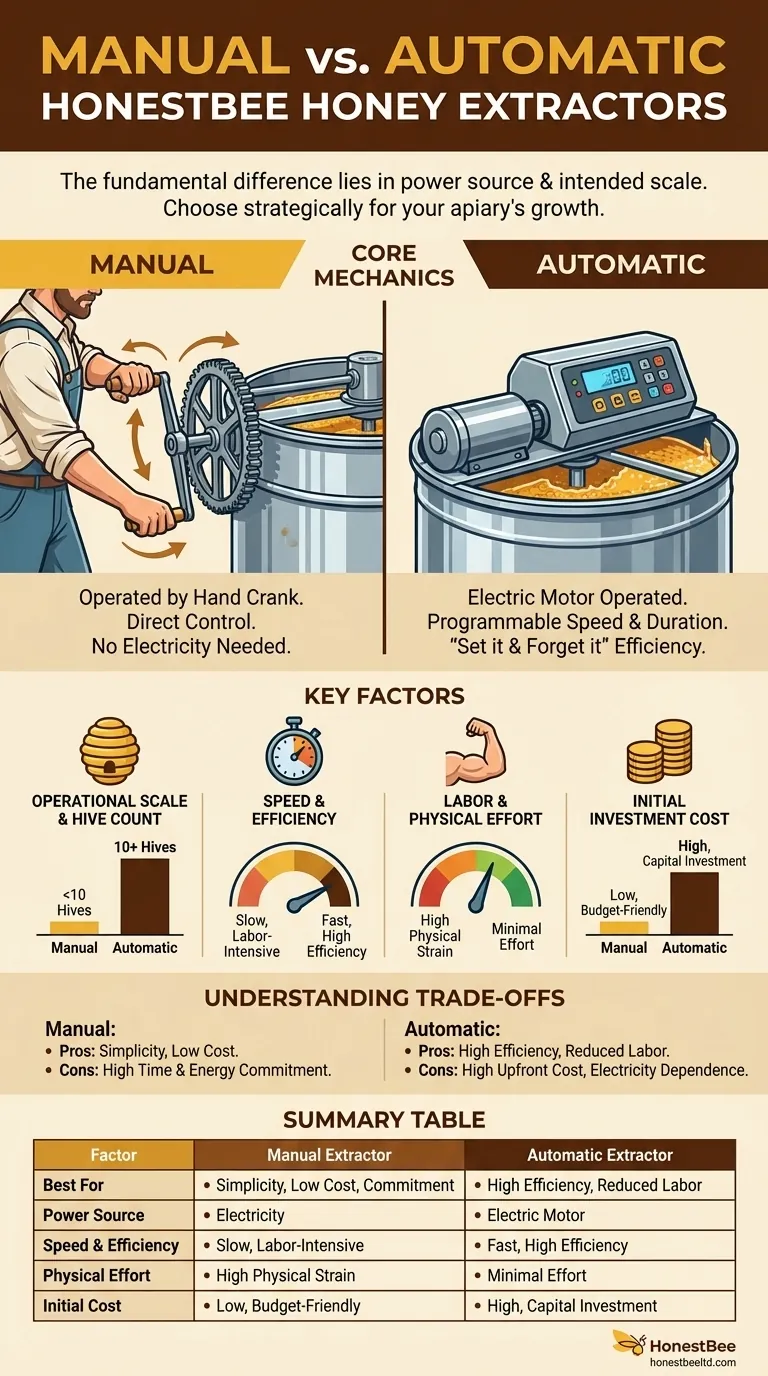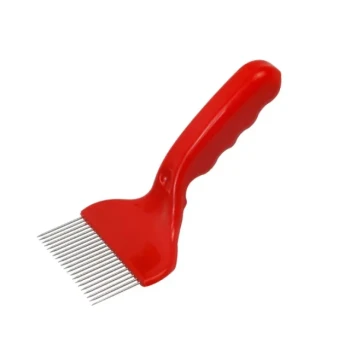The fundamental difference between manual and automatic honey extractors lies in their power source and intended scale. Manual extractors are operated by a hand crank, making them a cost-effective but labor-intensive option for hobbyists. Automatic (or electric) extractors use a motor to do the work, offering significant speed and efficiency for larger-scale or commercial beekeepers at a higher initial cost.
Your choice of an extractor is less about the technology itself and more about a strategic decision for your apiary. The right tool aligns directly with your hive count, your physical capacity, and your long-term goals as a beekeeper.

The Core Mechanics: Crank vs. Motor
The goal of any extractor is the same: to use centrifugal force to sling honey out of the comb without destroying the delicate wax structure. How they generate that force is the key distinction.
How Manual Extractors Work
A manual extractor is a simple, robust machine. After placing uncapped frames inside the drum, you turn a hand crank, which spins the internal basket.
This direct physical involvement means you control the speed entirely. It requires no electricity, making it a reliable option for extracting honey in remote locations or off-grid apiaries.
How Automatic Extractors Work
An automatic extractor replaces the hand crank with an electric motor. Once you load the frames and secure the lid, you simply set the speed and duration on a control panel and turn it on.
More advanced models offer programmable cycles that automatically increase the speed in stages. This "set it and forget it" functionality frees you to perform other tasks, like uncapping the next batch of frames, dramatically increasing overall workflow efficiency.
Key Factors in Your Decision
Choosing between these two types involves balancing four critical factors: scale, speed, effort, and cost.
Operational Scale and Hive Count
This is the most important consideration. A manual extractor is perfectly suited for a hobbyist with fewer than 10 hives. The time commitment is manageable at this scale.
An automatic extractor becomes a near-necessity for anyone with 10 or more hives. The time saved during extraction for a dozen or more hives is substantial, turning a multi-day chore into a single day's work.
Speed and Efficiency
There is no contest here. An automatic extractor is significantly faster. It spins frames at a consistent and optimal speed, extracting more honey in less time.
While the automatic extractor runs, you are free. With a manual extractor, you are the motor, and the entire process stops the moment you do.
Labor and Physical Effort
Manual extraction is a workout. Cranking a fully loaded extractor requires considerable and sustained physical effort. It can be tiring, especially when processing multiple batches of frames.
An automatic extractor reduces labor to loading and unloading frames. This minimizes physical strain and makes the process accessible to people of all physical abilities.
Initial Investment Cost
Manual extractors are the budget-friendly entry point. They are significantly cheaper to purchase, lowering the barrier to entry for new beekeepers.
Automatic extractors represent a serious capital investment. Their cost can be several times that of a manual model, positioning them as a tool for those who are scaling up their operation or running a business.
Understanding the Trade-offs
Neither option is universally superior; each comes with clear compromises that you must weigh against your specific needs.
The Manual Extractor: Simplicity at a Cost
The primary trade-off for the low cost and simplicity of a manual extractor is your time and energy. What you save in money, you pay for in sweat and hours spent cranking. For a small number of hives, this is a reasonable trade. As your apiary grows, it quickly becomes a bottleneck.
The Automatic Extractor: Efficiency Comes with a Price
The high efficiency of an automatic extractor is traded for high upfront cost and a reliance on electricity. It may be unjustifiable overkill for a beekeeper with only two or three hives. Furthermore, you must have a reliable power source available where you plan to do your extracting.
A Note on Honey Quality and Comb Preservation
Both extractor types can produce exceptional honey. However, the consistent and often programmable speed of an automatic extractor can be gentler on the comb than the variable force of manual cranking. This can lead to fewer "blowouts" (where the wax comb breaks apart), preserving your frames for the bees to use again.
Making the Right Choice for Your Apiary
Your decision should be a direct reflection of your goals. Consider your current operation and where you want it to be in the next few years.
- If your primary focus is hobby beekeeping (fewer than 10 hives): A manual extractor is the logical and most cost-effective choice to learn the process without a large investment.
- If your primary focus is growing a business (10+ hives): An automatic extractor is a necessary investment to maximize your efficiency, reduce labor costs, and enable you to scale.
- If your primary focus is physical ease, regardless of hive count: An automatic extractor is the superior choice for minimizing strain, provided your budget allows for the expense.
Ultimately, the best extractor is the one that serves your specific ambition as a beekeeper.
Summary Table:
| Factor | Manual Extractor | Automatic Extractor |
|---|---|---|
| Best For | Hobbyists (<10 hives) | Commercial beekeepers (10+ hives) |
| Power Source | Hand crank | Electric motor |
| Speed & Efficiency | Slow, labor-intensive | Fast, high efficiency |
| Physical Effort | High | Minimal |
| Initial Cost | Low | High |
Ready to scale your honey production efficiently?
Whether you're a commercial apiary or a beekeeping equipment distributor, HONESTBEE supplies the robust, wholesale-focused honey extractors and beekeeping equipment you need to succeed. Our automatic extractors are designed for high-volume operations, saving you time and labor, while our manual models provide a reliable, cost-effective solution for smaller-scale needs.
Let us help you choose the perfect equipment for your goals. Contact HONESTBEE today to discuss your requirements and get a wholesale quote!
Visual Guide

Related Products
- 6 Frame Manual Stainless Steel Honey Extractor Beekeeping Equipment
- HONESTBEE 3-Frame Manual Acrylic Honey Extractor
- HONESTBEE 72 Frame Industrial Electric Honey Extractor for Beekeeping
- Commercial Electric 12 Frame Honey Extractor Spinner Motorized Honey Extractor
- 2 Frame Stainless Steel Manual Honey Spinner Extractor for Beekeeping
People Also Ask
- What type of honey extractor is best? Maximize Your Harvest Efficiency with the Right Choice
- What is the basic principle of the honey extractor? Harness Centrifugal Force for Efficient Harvesting
- How many frames can different types of honey extractors hold? Maximize Your Harvest Efficiency
- What is the relationship between beeswax harvesting and honey extraction? An Inseparable Process Explained
- How long does it take to extract honey with an extractor? Plan Your Harvest for Maximum Efficiency



















